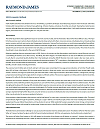
Economists Expect a Strong Showing in Second Half of 2021
December 29, 2020
Raymond James Chief Economist Dr. Scott Brown reflects on the trials and tribulations of 2020 and discusses his outlook for the new year.
The COVID-19 pandemic had a significant impact on economic activity in 2020, and we should see a rebound from those effects in 2021. The major hit to the economy was in sectors where individuals come into close contact with others:
- Consumer services, including tourism
- Air travel
- Sporting events
- Concerts
- Brick-and-mortar retail shopping and restaurants
State and local restrictions on social distancing amplified these effects, but voluntary self-isolation appears to have been a bigger factor. The November/December surge in COVID-19 cases is likely to dampen the pace of economic improvement into early 2021, but not lead to an overall contraction in economic activity. The arrival of vaccines should lead to more robust growth in the second half of the year.
Early in 2020, the concern was that the pandemic would lead to a broad financial crisis and a snowballing of weakness across the economy. Thankfully, that didn’t happen. The Federal Reserve (Fed) cut rates to the effective zero lower bound in early March, relaunched liquidity facilities that it had employed during the 2008-09 financial crisis (and created a few new ones), and restarted large-scale asset purchases (what most people call quantitative easing or “QE”). Lawmakers in Washington passed a massive fiscal support package, which included healthcare expenditures, “recovery rebates” (checks and deposits), support for small businesses, extended unemployment benefits, and aid to state and local governments.
The economy lost 20 million jobs in March and April. Job losses were concentrated in low-wage service industries. As Fed Chair Jerome Powell noted, about 40% of those in the bottom 20% of income earners lost jobs in those two months, with more moderate job losses among higher-wage workers. However, low-wage, low-productivity jobs were shed within a wide range of industries. Absent these workers, average hourly earnings jumped and productivity growth surged, but that’s simply an arithmetic artifact. The economy regained 12.3 million jobs from April to November, leaving us 9.8 million (6.4%) short of where we were in February.
Listen to the latest For What It's Worth podcast episode featuring Dr. Scott Brown:
Businesses and consumers adapted to living under the pandemic. White collar workers were more able to work from home. Telecommuting is expected to continue after the pandemic has passed. This shift strengthened the demand for housing. With a limited ability to spend on consumer services, mid- and upper-income households saw their savings rise, which helped boost spending on consumer durable goods. By October, consumer spending on motor vehicles, home furnishings, and home improvement were substantially higher than before the pandemic, although strength appeared to fade into November. The increase in household savings is expected to help fuel the rebound in consumer services as vaccines are distributed, but many individuals may not accept a vaccine and others may be reluctant to resume pre-pandemic behaviors.
Some pandemic-related changes to the economy may be long lasting. For many years, consumers have increasingly shopped online. That trend ramped sharply higher through the pandemic, leading to a surge in delivery and warehouse jobs. Brick-and-mortar retailing had already been weakening in the years before the pandemic and may be slow to recover. While residential housing is expected to remain strong, commercial real estate is likely to remain soft (except for warehousing). People may return to the office, but not fully, leading to reduced demand for office space.
Spending on consumer services should begin to expand more rapidly as vaccines are distributed, leading to a strong pace of recovery in the second half of 2021. Long-term interest rates can be expected to rise as that happens, but not too rapidly.

Read the full 2021 Economic Outlook from Dr. Scott Brown
Podcast recorded December 18, 2020 and hosted by Public Content Manager Paige Lenssen, CFA. All expressions of opinion reflect the judgment of the author, and are subject to change. This information should not be construed as a recommendation. The foregoing content is subject to change at any time without notice. Content provided herein is for informational purposes only. There is no guarantee that these statements, opinions or forecasts provided herein will prove to be correct.

